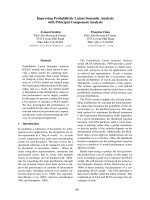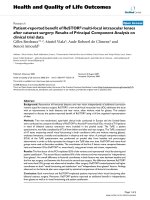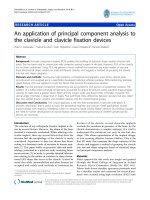Principal component analysis in rainfed green gram genotypes [Vigna radiata (L.) Wilczek]
Bạn đang xem bản rút gọn của tài liệu. Xem và tải ngay bản đầy đủ của tài liệu tại đây (224.39 KB, 7 trang )
Int.J.Curr.Microbiol.App.Sci (2020) 9(5): 1315-1321
International Journal of Current Microbiology and Applied Sciences
ISSN: 2319-7706 Volume 9 Number 5 (2020)
Journal homepage:
Original Research Article
/>
Principal Component Analysis in Rainfed
Green Gram Genotypes [Vigna radiata (L.) Wilczek]
Champa Lal Khatik*
Plant Breeding and Genetics, Agricultural Research Station, Fatehpur-Shekhawati,
Sikar, Rajasthan, (SKN Agriculture University, Jobner), India
*Corresponding author
ABSTRACT
Keywords
principal
component analysis,
green gram,
genotypes
Article Info
Accepted:
10 April 2020
Available Online:
10 May 2020
The present investigation entitled “Principal component analysis in rainfed green gram
genotypes [Vigna radiata (L.) Wilczek]” was carried out to determine the relationship and
genetic diversity among 16 green gram genotypes using principal component analysis for
various characters during Kharif, 2019 at Agricultural Research Station, Fatehpur Shekhawati, Sikar (Rajasthan) under rainfed conduction. Principal component analysis
(PCA) depicted that three components (PC1 to PC3) accounted for about more than 90%
of the total variation for different characters. Out of total principal components retained
V1, V2, V3 and V4 with values of 39.15%, 25.29%, 15.72% and 10.79 respectively. PCA
based clustering showed that genotypes fall in to five different clusters showed genetic
diversity between different genotypes. The Genotypes MSJ-118 and RMG-1094 which
represents the mono genotypic cluster signifies that it could be the most diverse from other
genotypes and it would be the suitable candidate for hybridization with genotypes present
in other clusters to tailor the agriculturally important characters and ultimately to enhance
the seed yield in green gram. Thus the results of principal component analysis revealed,
wide genetic variability exists in these green gram genotypes. Hence these could be
utilized as parental material in future breeding programme for green gram improvement.
Introduction
Green gram (Vigna radiata (L.) Wilczek) is
one of the important pulse crops in arid region
because of its short growth duration,
adaptation to low water requirement and low
soil fertility (Raturi et al., 2015). It is favored
for consumption due to its easy digestibility
and low production of flatulence.
Pulses are extensively grown in tropical
regions of the world as a major protein rich
crop bringing considerable improvement in
human diet (Muthuswamy et al., 2019 and
Rahim et al., 2010).
Average protein content in the seed is around
24 per cent. The protein is comparatively rich
in the amino acid lysine but predominantly
1315
Int.J.Curr.Microbiol.App.Sci (2020) 9(5): 1315-1321
deficient in cereal grains (Baskaran et al.,
2009 Garg et al., 2017 and Dhanajay et al.,
2009). Presently, the yield of green gram is
well below the optimum level compare to
other pulses. Green gram (Vigna radiata (L.)
Wilczek) is one of the chief pulse crops
grown in India after chickpea and pigeon pea.
In India, green gram is cultivated in 4.26
million ha with a production of 2.01 million
tonnes and productivity of 472 kg/ha (AICRP
on MULLaRP, 2018-19).
The average yield of green gram is very low
not only in India but in entire tropical and
sub-tropical Asia (Pratap et al., 2012 and
Kumar et al., 2005).Grouping of green gram
genotypes based on genetic divergence for
different characters will enable breeders for
the better selection of parents during
hybridization (Tripathi,2019).
In plant breeding, genetic diversity plays an
important role because hybrids between
genetically diverse parents manifest greater
heterosis than those between more closely
related parents (Mahalingam et al., 2018).
Some appropriate methods viz., factor
analysis, cluster analysis and PCA helps in
parental selection and genetic diversity
identification. Recently PCA has been cited
by various authors for the reduction of
multivariate data into a few artificial varieties
which can be further used for cla����������������������������������������������������������������������������������������������������������������������������������������������������������������������������������������������������������������������������������������������������������������������������������������������������������������������������������������������������������������������������������������������������������������������������������������������������������������������������������������������������������������������������������������������������������������������������������������������������������������������������������������������������������������������������������������������������������������������������������������������������������������������������������������������������������������������������������������������������������������������������������������������������������������������������������������������������������������������������������������������������������������������������������������������������������������������������������������������������������������������������������������������������������������������������������������������������������������������������������������������������������������������������������������������������������������������������������������������������������������������������������������������������������������������������������������������������������������������������������������������������������������������������������������������������������������������������������������������������������������������������������������������������������������������������������������������������������������������������������������������������������������������������������������������������������������������������������������������������������������������������������������������������������������������������������������������������������������������������������������������������������������������������������������������������������������������������������������������������������������������������������������������������������������������������������������������������������������������������������������������������������������������������������������������������������������������������������������������������������������������������������������������������������������������������������������������������������������������������������������������������������������������������������������������������������������������������������������������������������������������������������������������������������������������������������������������������������������������������������������������������������������������������������������������������������������������������������������������������������������������������������������������������������������������������������������������������������������������������������������������������������������������������������������������������������������������������������������������������������������������������������������������������������������������������������������������������������������������������������������������������������������������������������������������������������������������������������������������������������������������������������������������������������������������������������������������������������������������������������������������������������������������������������������������������������������������������������������������������������������������������������������������������������������������������������������������������������������������������������������������������������������������������������������������������������������������������������������������������������������������������������������������������������������������������������������������������������������������������������������������������������������������������������������������������������������������������������������������������������������������������������������������������������������������������������������������������������������������������������������������������������������115
4. PL(cm)
0.19186
-0.57640
-0.06372
0.22409
5. No. of S/P
0.44940
0.24967
0.09027
0.34440
6. SY/Plot (g)
-0.35346
-0.20077
0.14473
0.75830
7. TW(g)
-0.01408
-0.45500
0.61164
-0.03680
8. SY(kg/ha)
-0.31530
0.52059
0.07075
0.38464
Characters
1317
Int.J.Curr.Microbiol.App.Sci (2020) 9(5): 1315-1321
Table.2 The PCA scores of 16 genotypes of green gram
PCA I
PCA II
PCA III
Genotypes
(X Vector)
(Y Vector)
(Z Vector)
1 | RMG-492
22.846
-10.636
54.930
2 | RMG-975
22.294
-12.615
56.403
3 | IPM-02-3
23.467
-13.328
58.283
4 | MSJ-118
24.342
-13.224
58.531
5 | RMG-1087
22.005
-13.213
57.716
6 | RMG-1094
25.162
-14.678
55.080
7 | RMG-1098
19.406
-12.754
55.639
8 | RMG-1132
17.980
-15.340
60.584
9 | RMG-1134
19.831
-11.219
56.220
10 | RMG-1137
20.192
-13.971
56.584
11 | RMG-1138
19.386
-13.077
56.551
12 | RMG-1139
20.947
-15.390
58.473
13 | RMG-1147
18.470
-16.134
60.325
14 | RMG-1148
22.782
-14.661
59.039
15 | RMG-1152
23.823
-11.891
57.842
16 | RMG-1154
23.619
-12.379
58.908
Table.3 K means clustering for 8 characters of green gram genotypes
K Mean Clustering
Characters
D50%F
DM
PH
PL
No. of
SY/
TW
SY
(cm)
(cm)
S/P
Plot (g)
(g)
(kg/ ha)
1 Cluster
40.500
61.667
41.875
7.708
10.667
217.917 32.800
605.323
2 Cluster
42.667
61.167
35.000
7.867
11.833
234.167 32.667
650.458
3 Cluster
37.333
59.833
44.208
7.658
10.833
280.000 30.758
777.774
4 Cluster
38.222
60.889
45.222
8.011
10.611
368.889 33.944 1020.572
5 Cluster
41.778
62.667
41.389
7.533
11.722
222.778 31.356
1318
618.826
Int.J.Curr.Microbiol.App.Sci (2020) 9(5): 1315-1321
Figure.1 Clustering of green gram genotypes by K means clustering method
Figure.2 Three dimensional graph showing relative position of green gram
genotypes based on PCA scores
1319
Int.J.Curr.Microbiol.App.Sci (2020) 9(5): 1315-1321
Hence, the major contributing characters for
the diversity in the second principal
component (V2) were days to flowering, days
to maturity, plant height, no. of seeds per
plant and seed yield kg per hectare (0.062,
0.282, 0.056, 0.249 and 0.520) while pod
length, seed yield per plot and test weight (0.576, -0.200 and -0.455). Only pod length (0.063) load negative contributed and other
characters positive contributed load for third
principal component (V3).
Similarly the characters days to flowering,
pod length, no. of seeds per pod, seed yield
per plot and seed yield kg per hectare (0.172,
0.224, 0.344, 0.758, 0.384) which load
positively while days to maturity, plant height
and test weight (-0.060, -0.271and -0.036)
negatively in fourth principal component (V4)
contributed more to the diversity and they
were the ones that most differentiated the
clusters. Similar results were obtained in
finding of Mahalingam et al., (2020) and
Thippani et al., (2017).
The PCA scores for 16 genotypes in the first
three principal components with eigen value
more than one were computed and presented
in Table-2. The PCA scores for 16 genotypes
plotted in 3D (PCA I as X axis, PCA II as Y
axis and PCA III as Z axis) scatter diagram
(Fig.-2).
On the PCA based clustering, 16 genotypes
were grouped into 5 clusters in which
maximum number of genotypes were fall in
cluster 1 and 3 (4 genotypes) followed by
cluster 4 and 5 (3 genotypes), whereas
minimum number of genotypes were in
cluster 2 (2 genotypes) (Table-3 and Figure1). On the basis of PCA, the maximum cluster
distance was obtained for cluster 4 (5.455)
followed by cluster 3 (4.385), cluster
1(3.461), cluster 5 (2.147) while minimum
cluster distance was obtained for cluster 2
(1.393).
These suggest that genotypes belonging to
clusters separated by high statistical distance
should be used in hybridization programme
for obtaining a wide spectrum of variation
among the segregants. Similar results were
obtained in finding of Jakhar and Kumar,
2018 and Thippani et al., 2017.
There is significant genetic variability among
tested genotypes that indicates the presence of
excellent opportunities to bring about
improvement through wide hybridization by
crossing genotypes with high genetic
distance. The information obtained from this
study can be used to plan crosses and
maximized the use of genetic diversity and
expression of heterosis. Hence these could be
utilized as parental material in future breeding
programme for green gram improvement.
References
AICRP on MULLarp, 2019. Project
Coordinator Report- (2018-19) All India
Coordinated Research Project on
MULLaRP, ICAR- Indian Institute of
Pulses Research, Kanpur-208204, Uttar
Pradesh, India, Pp 35-39.
Baskaran,
L.,
Sundararmoorthy,
P.,
Chidambaram, A.L.A. and Ganesh,.
K.S. 2009. Growth and physiological
activity of green gram (Vigna radiata
(L.) Wilczek) under effluent stress. Bot.
Res. Int., 2: 107-114.
Chahal GS, Gosal SS, 2002.Principles and
Procedures
of
Plant
Breeding:
Biotechnological and Conventional
Approaches.
Alpha
Science
International: 604.
Dhananjay, Ramakant, Singh, B. N. and
Singh, G.2009. Studies on genetic
variability, correlations and path
coefficients analysis in mung bean.
Crop Res. Hisar. 38(1/3): 176-178.
Garg, G. K., Verma, P. K. and Kesh, H. 2017.
Genetic Variability, Correlation and
1320
Int.J.Curr.Microbiol.App.Sci (2020) 9(5): 1315-1321
Path Analysis in Greengram [Vigna
radiata (L.) Wilczek]. Int. J. Curr.
Microbiol. App. Sci., 6(11): 2166-2173.
Hadavani JK, Mehta DR, Ansodariya SN and
Gadhiya KK,2018.Principal component
analysis and cluster analysis in Indian
bean
(Lablab
purpureus
L.).International Journal of Chemical
Studies, 6(4): 1448-1452.
Jakhar, N.K. and Kumar,A.,2018. Principal
component analysis and character
association for yield components in
greengram [Vigna radiata (L.) Wilczek]
genotypes. Journal of Pharmacognosy
and Phytochemistry, 7(2): 3665-3669.
Kumar,U., S.P.Singh and Vikas 2005.
Variability and character association in
mungbean.
(Vigna
radiata
(L.)
Wilczek). New Agriculturist, 16 (1, 2):
23-28.
Mahalingam A, Manivannan N, Ragul S and
Lakshmi Narayanan S, 2018. Genetic
divergence among greengram (Vigna
radiata (L.) Wilczek) germplasm
collections. Electronic Journal of Plant
Breeding, 9 (1) : 350 – 354.
Mahalingam A, Manivannan N, Bharathi
Kumar K., Ramakrishnan P. and
Vadivel K.,2020. Character association
and principal component analysis for
seed yield and its contributing
characters in greengram (Vigna radiata
(L.) Wilczek). Electronic Journal of
Plant Breeding, 11(1): 259-262.
Muthuswamy, A., Jamunarani, M. and
Ramakrishnan,
P.
2019.Genetic
Variability, Character Association and
Path Analysis Studies in Green Gram
(Vigna
radiata
(L.)
Wilczek).
Int.J.Curr.Microbiol.App.Sci.,
8(4):
1136-1146.
Pratap, A., Gupta., D.S. and Rajan., N.
2012.Breeding Indian Field Crops. Agro
bios Publishers, New Delhi, India. p
208-227.
Rahim, M. A., Mia, A. A., Mahmud, F., Zeba,
N. and Afrin, K. S. 2010. Genetic
variability, character association and
genetic divergence in mungbean (Vigna
radiata (L.) Wilczek). Plant Omics.
3(1): 1-6.
Raturi, A., Singh, S. K., Sharma, V. and
Pathak, R. 2015. Genetic variability,
heritability, genetic advance and path
analysis in Greengram [Vigna radiata
(L.) Wilczek]. Legume Res., 38 (2):
157-163.
Sharma JR,1998. Statistical and biometrical
techniques in plant breeding. New Age
International, New Delhi: 432.
Thippani S, Eshwari KB, Bhave MHV,2017.
Principal component analysis for yield
components in Greengram Accessions
(Vigna radiata L.). Int. J Pure App.
Biosci.; 5(4):246-253.
Tripathi, A.K. 2019. Feeling the Pulse:
Towards Production Expansion of
Pulses in India. Journal of Asian and
African Studies, 54(6):894-912.
How to cite this article:
Champa Lal Khatik. 2020. Principal Component Analysis in Rainfed Green Gram Genotypes
[Vigna radiata (L.) Wilczek]. Int.J.Curr.Microbiol.App.Sci. 9(05): 1315-1321.
doi: />
1321









